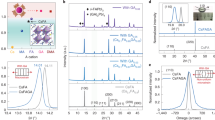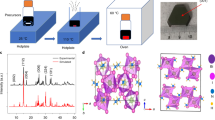Abstract
The large mobilities and carrier lifetimes of hybrid perovskite single crystals and the high atomic numbers of Pb, I and Br make them ideal for X-ray and gamma-ray detection. Here, we report a sensitive X-ray detector made of methylammonium lead bromide perovskite single crystals. A record-high mobility–lifetime product of 1.2 × 10–2 cm2 V–1 and an extremely small surface charge recombination velocity of 64 cm s–1 are realized by reducing the bulk defects and passivating surface traps. Single-crystal devices with a thickness of 2–3 mm show 16.4% detection efficiency at near zero bias under irradiation with continuum X-ray energy up to 50 keV. The lowest detectable X-ray dose rate is 0.5 μGyair s–1 with a sensitivity of 80 μC Gy−1air cm–2, which is four times higher than the sensitivity achieved with α-Se X-ray detectors. This allows the radiation dose applied to a human body to be reduced for many medical and security check applications.
This is a preview of subscription content, access via your institution
Access options
Subscribe to this journal
Receive 12 print issues and online access
$209.00 per year
only $17.42 per issue
Buy this article
- Purchase on Springer Link
- Instant access to full article PDF
Prices may be subject to local taxes which are calculated during checkout




Similar content being viewed by others
References
Kasap, S. et al. Amorphous and polycrystalline photoconductors for direct conversion flat panel X-ray image sensors. Sensors 11, 5112–5157 (2011).
Yaffe, M. J. & Rowlands, J. A. X-ray detectors for digital radiography. Phys. Med. Biol. 42, 1–39 (1997).
Tegze, M. & Faigel, G. X-ray holography with atomic resolution. Nature 380, 49–51 (1996).
Shah, K. S. et al. X-ray imaging with PbI2-based a-Si:H flat panel detectors. Nucl. Instrum. Methods Phys. Res. A 458, 140–147 (2001).
Kasap, S. O. X-ray sensitivity of photoconductors: application to stabilized a-Se. J. Phys. D 33, 2853 (2000).
Brenner, D. J., Elliston, C. D., Hall, E. J. & Berdon, W. E. Estimated risks of radiation-induced fatal cancer from pediatric CT. Am. J. Roentgenol. 176, 289–296 (2001).
Eisen, Y. & Shor, A. CdTe and CdZnTe room-temperature X-ray and gamma ray detectors and imaging systems. IEEE Trans. Nucl. Sci. 487, 1191–1198 (2004).
Szeles, C. CdZnTe and CdTe materials for X-ray and gamma ray radiation detector applications. Phys. Status Solidi 241, 783–790 (2004).
Kabir, M. Z. & Kasap, S. O. Charge collection and absorption-limited sensitivity of X-ray photoconductors: applications to a-Se and HgI2 . Appl. Phys. Lett. 80, 1664–1666 (2002).
Luke, P. N., Rossington, C. S. & Wesela, M. F. Low energy X-ray response of Ge detectors with amorphous Ge entrance contacts. IEEE Trans. Nucl. Sci. 41, 1074–1079 (1994).
Jeong, M., Jo, W. J., Kim, H. S. & Ha, J. H. Radiation hardness characteristics of Si-PIN radiation detectors. Nucl. Instrum. Methods Phys. Res. A 784, 119–123 (2015).
Evans, R. D. & Noyau, A. The Atomic Nucleus Vol. 582 (McGraw-Hill, 1955).
Bi, C. et al. Non-wetting surface-driven high-aspect-ratio crystalline grain growth for efficient hybrid perovskite solar cells. Nature Commun. 6, 7747 (2015).
Jeon, N. J. et al. Compositional engineering of perovskite materials for high-performance solar cells. Nature 517, 476–480 (2015).
Liu, M., Johnston, M. B. & Snaith, H. J. Efficient planar heterojunction perovskite solar cells by vapour deposition. Nature 501, 395–398 (2013).
Yang, W. S. et al. High-performance photovoltaic perovskite layers fabricated through intramolecular exchange. Science 348, 1234–1237 (2015).
Zhou, H. et al. Interface engineering of highly efficient perovskite solar cells. Science 345, 542–546 (2014).
Burschka, J. et al. Sequential deposition as a route to high-performance perovskite-sensitized solar cells. Nature 499, 316–319 (2013).
Xing, G. et al. Long-range balanced electron- and hole-transport lengths in organic–inorganic CH3NH3PbI3 . Science 342, 344–347 (2013).
Yakunin, S. et al. Detection of X-ray photons by solution-processed lead halide perovskites. Nature Photon. 9, 444–449 (2015).
Dong, Q. et al. Electron–hole diffusion lengths >175 µm in solution-grown CH3NH3PbI3 single crystals. Science 347, 967–970 (2015).
Saidaminov, M. I. et al. High-quality bulk hybrid perovskite single crystals within minutes by inverse temperature crystallization. Nature Commun. 6, 7586 (2015).
Yang, Y. et al. Low surface recombination velocity in solution-grown CH3NH3PbBr3 perovskite single crystal. Nature Commun. 6, 7961 (2015).
Shi, D. et al. Low trap-state density and long carrier diffusion in organolead trihalide perovskite single crystals. Science 347, 519–522 (2015).
Castelli, I. E., Thygesen, K. S. & Jacobsen, K. W. Calculated optical absorption of different perovskite phases. J. Mater. Chem. A 3, 12343–12349 (2015).
Androulakis, J. et al. Dimensional reduction: a design tool for new radiation detection materials. Adv. Mater. 23, 4163–4167 (2011).
Stoumpos, C. C. et al. Crystal growth of the perovskite semiconductor CsPbBr3: a new material for high-energy radiation detection. Cryst. Growth Des. 13, 2722–2727 (2013).
Bi, Y. et al. Charge carrier lifetimes exceeding 15 μs in methylammonium lead iodide single crystals. J. Phys. Chem. Lett. 7, 923–928 (2016).
Fang, Y. et al. Highly narrowband perovskite single-crystal photodetectors enabled by surface-charge recombination. Nature Photon. 9, 679–686 (2015).
Hsieh, P. T., Chen, Y. C., Kao, K. S. & Wang, C. M. Luminescence mechanism of ZnO thin film investigated by XPS measurement. Appl. Phys. A 90, 317–321 (2008).
Casalongue, H. S. et al. Direct observation of the oxygenated species during oxygen reduction on a platinum fuel cell cathode. Nature Commun. 4, 2817 (2013).
Yin, W.-J. et al. Origin of high electronic quality in structurally disordered CH3NH3PbI3 and the passivation effect of Cl and O at grain boundaries. Adv. Electron. Mater. 1, 1500044 (2015).
Schmidt, J. et al. Surface passivation of high-efficiency silicon solar cells by atomic-layer-deposited Al2O3 . Prog. Photovoltaics 16, 461–466 (2008).
Xiao, Z. et al. Giant switchable photovoltaic effect in organometal trihalide perovskite devices. Nature Mater. 14, 193–198 (2015).
Guo, F. et al. A nanocomposite ultraviolet photodetector based on interfacial trap-controlled charge injection. Nature Nanotech. 7, 798–802 (2012).
Wei, H. et al. Trap engineering of CdTe nanoparticle for high gain, fast response, and low noise P3HT:CdTe nanocomposite photodetectors. Adv. Mater. 27, 4975–4981 (2015).
Berger, M. J. et al. XCOM: Photon Cross Sections Database: NIST Standard Reference Database 8 (NIST, 2013).
Dvoryankin, V. F. et al. X-ray sensitivity of Cd0.9Zn0.1Te detectors. Tech. Phys. 55, 306–308 (2010).
Schieber, M. et al. Theoretical and experimental sensitivity to X-rays of single and polycrystalline HgI2 compared with different single-crystal detectors. Nucl. Instrum. Methods Phys. Res. A 458, 41–46 (2001).
Shearer, D. R. & Bopaiah, M. Dose rate limitations of integrating survey meters for diagnostic X-ray surveys. Health Phys. 79, S20–S21 (2000).
Clairand, I. et al. Use of active personal dosemeters in interventional radiology and cardiology: tests in laboratory conditions and recommendations—ORAMED project. Radiat. Meas. 46, 1252–1257 (2011).
Devanathan, R., Corrales, L. R., Gao, F. & Weber, W. J. Signal variance in gamma-ray detectors—a review. Nucl. Instrum. Methods Phys. Res. A 565, 637–649 (2006).
Acknowledgements
The majority of this work was supported financially by the Defense Threat Reduction Agency (award no. HDTRA1-14-1-0030). M.A.L. acknowledges funding from the European Research Council (ERC starting grant ‘Hy-SPOD’ no. 306983). Y.G. acknowledges support from the National Science Foundation (grant no. CBET-1437656).
Author information
Authors and Affiliations
Contributions
J.H. conceived and supervised the project. H.W. synthesized materials, fabricated the device and measured the optoelectronic properties and photodetector performance. P.M., W.C. and L.C. measured the device properties under X-ray radiation. H.W., Y.F. and P.M. calculated the charge collection efficiency under X-ray radiation. H.H.F. and M.A.L. performed photoluminescence and photoluminescence lifetime measurements. C.W., B.E. and Y.G. carried out XPS measurement. All authors analysed the data. J.H. and H.W. wrote the manuscript, and all authors reviewed it.
Corresponding authors
Ethics declarations
Competing interests
The authors declare no competing financial interests.
Supplementary information
Supplementary information
Supplementary information (PDF 1218 kb)
Rights and permissions
About this article
Cite this article
Wei, H., Fang, Y., Mulligan, P. et al. Sensitive X-ray detectors made of methylammonium lead tribromide perovskite single crystals. Nature Photon 10, 333–339 (2016). https://doi.org/10.1038/nphoton.2016.41
Received:
Accepted:
Published:
Issue Date:
DOI: https://doi.org/10.1038/nphoton.2016.41
This article is cited by
-
Cation-π interactions enabled water-stable perovskite X-ray flat mini-panel imager
Nature Communications (2024)
-
Vapor-deposited lead-free all-inorganic perovskite films with ultralow dark current for sensitive and stable X-ray detection
Journal of Materials Science: Materials in Electronics (2024)
-
Detector-grade perovskite single-crystal wafers via stress-free gel-confined solution growth targeting high-resolution ionizing radiation detection
Light: Science & Applications (2023)
-
Rheological engineering of perovskite suspension toward high-resolution X-ray flat-panel detector
Nature Communications (2023)
-
Efficient X-ray luminescence imaging with ultrastable and eco-friendly copper(I)-iodide cluster microcubes
Light: Science & Applications (2023)



